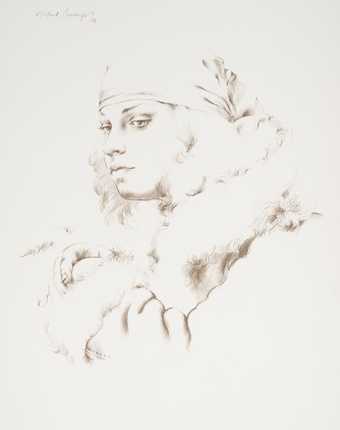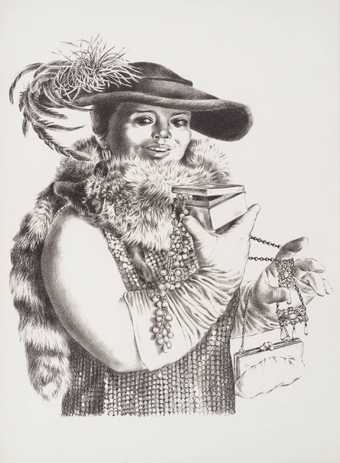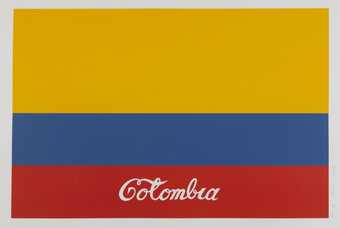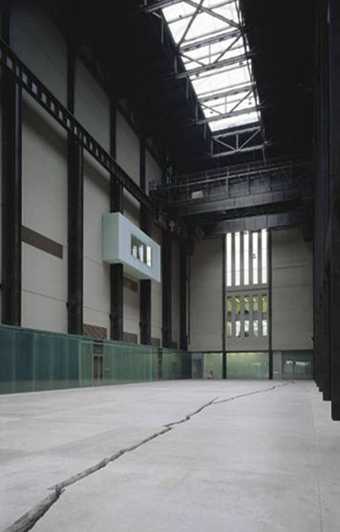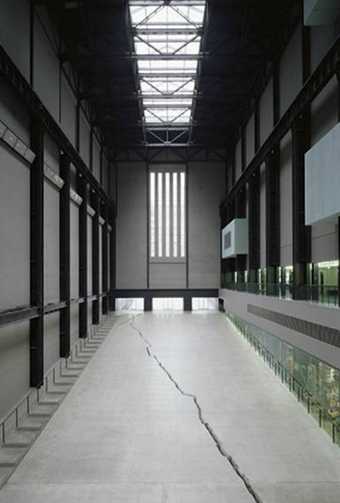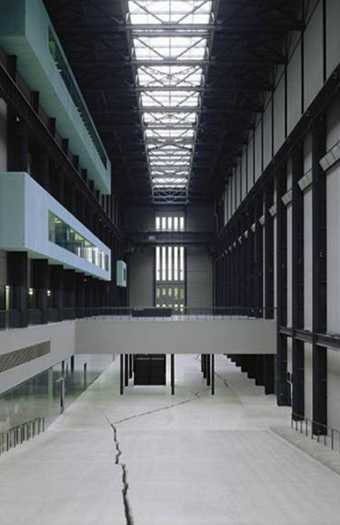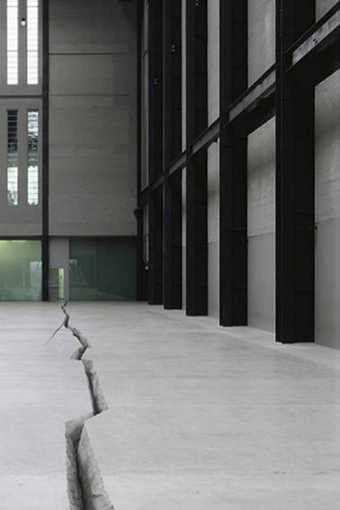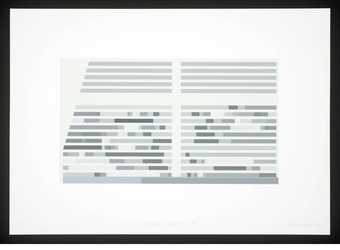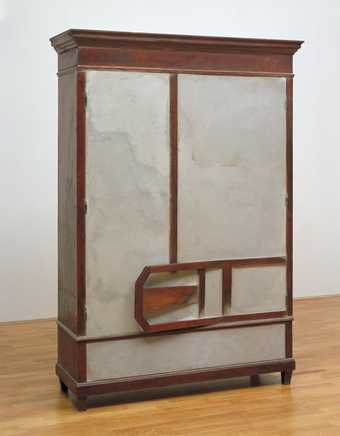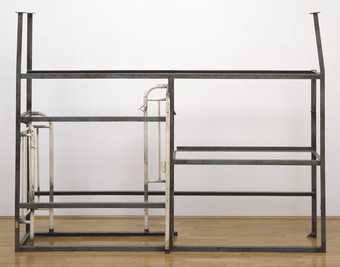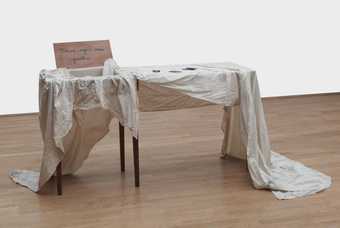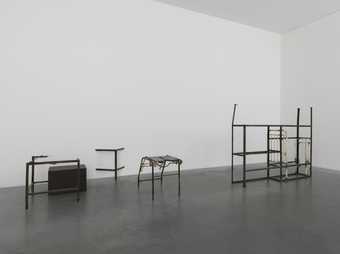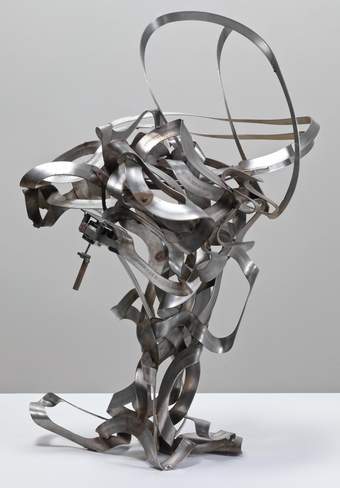Not on display
- Artist
- Doris Salcedo born 1958
- Medium
- Wood, thread and hair
- Dimensions
- Object: 800 × 750 × 3150 mm
- Collection
- Tate
- Acquisition
- Presented by the Patrons of New Art through the Tate Gallery Foundation 1999
- Reference
- T07523
Summary
Unland: audible in the mouth is one of a group of three sculptures collectively titled Unland that Salcedo created in 1995-8. The works are a response to the testimonies of children who witnessed their parents’ murder during Colombia’s civil war. As part of the process of creating the Unland works, the artist travelled to a northern region of the country to research the experiences of these orphans and the ways their lives developed as a result of their trauma. Unland: the orphan’s tunic, 1997 (Funcació ‘la Caixa’ Barcelona), Unland: irreversible witness, 1995-8 (San Francisco Museum of Modern Art) and Unland: audible in the mouth (the last and most minimal of the series) were all made by fusing two old wooden tables into one. Salcedo bought the pine and oak tables she used to make Unland: audible in the mouth in Bogotá, where she lives and works. The two tables have been joined by sawing off the legs at one end of each table and fitting the legless ends together. The artist and her assistants drilled thousands of tiny holes into the tables’ surfaces before a team of volunteers laboriously threaded a combination of human hair and split silk fibres through the holes to cover much of the wood. The ‘stitching’ crosses the hybrid table against the length of the grain, and varies in density and colour. Salcedo used black and dark brown Colombian women’s hair she sourced from a local hairdresser and raw white silk. The silk threads are most dense at the end of the pine table, where they also encircle the legs and cover the sides; the ratio of silk to hair gradually decreases towards the central join where hair then supersedes silk on the wider oak table. Deep cuts scored lengthways into the table tops as part of the stitching process evoke controlled wounding, very different from the shallow grooves and notches scratched into the wood during its life as a table in a home. The surface of fine thread and hairs that cover much of the wooden surface recalls the veil of cobwebs that appears in abandoned places and on objects not touched for a long time.
Salcedo studied art and art history at Bogotá University (BFA 1980) where she majored in painting and theatre and was particularly inspired by her teacher, the painter Beatriz Gonzalez (born 1938). She began making sculpture in New York in the early 1980s, while attending New York University (MA 1984). Here she encountered the work of Joseph Beuys (1921-86), whose notion of ‘social sculpture’ – integrating political awareness with making – and his focus on materials to convey specific meanings were a significant influence on her. She began to think of sculpture as ‘a crossroad, a meeting point’ (quoted in Basualdo, p.11), of ideology, theory, materials and objects. In New York, Saldedo also experienced being a displaced outsider – a sense she retained on her return to Bogotá in 1985, where she deliberately maintained her peripheral position in order to have a critical distance on Colombian society.
Since the mid 1980s, Salcedo has based her work on the experiences of Colombian people whose lives have been damaged by the country’s civil war. During the 1990s, the artist interviewed the relatives of dead and missing people and did extensive research into the records of humanitarian workers. From these stories she created sculptures that poetically resonate with the affects of loss and horror resulting from the trauma of extreme violence. Salcedo invented the title Unland to express the conditions of dispossession and displacement created by war. In Colombia most of those suffering these conditions are in the most distant rural areas of the country and have no voice and no presence to make their suffering known. The word ‘un-land’ suggests a reversal of some kind – a place that is no longer a place, a country that no longer exists. ‘Un-land’ evokes the impossibility to imagine or to express the trauma suffered by children who see their parents die violently and whose lives are irrevocably damaged by this experience. The phrase ‘audible in the mouth’ is derived from a poem by the German-speaking Jewish Romanian poet Paul Celan (1920-70), whose writing was driven by the Holocaust in which his parents perished. To express horrors for which there were no words, Celan invented hybrid and fragmented words or forms of language, ultimately inspiring Salcedo to do the same. The phrase ‘audible in the mouth’, taken from Celan’s poem An Eye, Open, first published in a collection entitled Sprachgitter or Language Mesh (1959), evokes words that cannot be taken into the body in the normal way – through the ears – but rather through the rather more visceral channel of the mouth. The ‘audible’ words, like the victims and their stories, are displaced to a place where a different kind of hearing occurs – a non-verbal gut-impacting expression of permanent emotional damage to which Salcedo’s Unland sculptures attempt to give visible form. They transform the neutral association of tables – around which a family might sit to share a meal – to the disturbing notion of a prop on which a body might be fixed to be tortured or a dead body might be cut open. The intense and pointless labour of stitching wood with hair and silk suggests an attempt to repair the irreparable affective damage of war.
Further reading:
Tanya Barson, ‘”Unland” The Place of Testimony, Doris Salcedo’s Unland: audible in the mouth
1998’, Contemporary Art in Focus, Patrons’ Paper 3, January 2004, London, http://www.tate.org.uk/research/tateresearch/tatepapers/04spring/unland_paper.htm.
Carlos Basualdo, Nancy Princenthal and Andreas Huyssen, Doris Salcedo, London 2000, pp.21, 25, reproduced pp.135, 136 and 138-9 in colour.
Unland: Doris Salcedo: New Work, exhibition brochure, San Francisco Museum of Modern Art, 1999, reproduced [p.4].
Elizabeth Manchester
December 2007
Does this text contain inaccurate information or language that you feel we should improve or change? We would like to hear from you.
Display caption
Over a period of three years, Salcedo traveled to the northern heartland of Colombia’s civil war and spoke to children who had witnessed the murder of their parents. These testimonies inspired a series
of three sculptures given the collective title Unland. Conjoining two fragmented tables, this work suggests the dysfunction caused by extreme trauma. ‘We spend our life around tables and their familiarity helps to draw you in’, Salcedo has said. ‘Yet these objects have been forcibly united... and appear to be like the mutated remains of an accident’.
Gallery label, July 2007
Does this text contain inaccurate information or language that you feel we should improve or change? We would like to hear from you.
Explore
- emotions, concepts and ideas(16,416)
-
- emotions and human qualities(5,345)
-
- victim(38)
- universal concepts(6,387)
- furnishings(3,081)
-
- table(754)
You might like
-
Rafael Penagos Woman with Fur Wrap
1976 -
Enrique Grau Jewel Box
1977 -
Donald Locke The Pork-Knocker Suite: Afro Leg
2003 -
Antonio Caro Colombia
1977 -
Doris Salcedo Shibboleth I
2007 -
Doris Salcedo Shibboleth II
2007 -
Doris Salcedo Shibboleth III
2007 -
Doris Salcedo Shibboleth IV
2007 -
Alison Turnbull Plant Bands and Systematic Sections
2007 -
Doris Salcedo Untitled
1998 -
Doris Salcedo Untitled
1987 -
Marepe Deposit your lice here
1999 -
Feliza Bursztyn The Mechanical Ballet
1979 -
Doris Salcedo Untitled
1986–7 -
Feliza Bursztyn Untitled
1968


